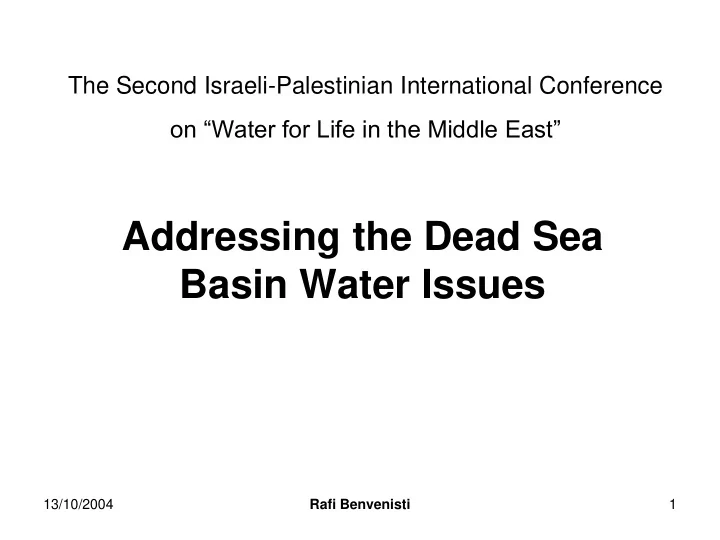

The Second Israeli-Palestinian International Conference on “Water for Life in the Middle East” Addressing the Dead Sea Basin Water Issues 13/10/2004 Rafi Benvenisti 1
13/10/2004 Rafi Benvenisti 2
The Dead Sea Water Basin • Total Area 41,000 Sq. Km – Jordan River 19,000 Sq. Km – Dead Sea 22,000 Sq. Km • Annual Water Availability 1,800 MCM/yr – Jordan River 1,500 MCM/yr – Dead Sea 350 MCM/yr • Annual Water Use – Jordan River 1,400 MCM/yr – Dead Sea (Potash plants – net) 250 MCM/yr 13/10/2004 Rafi Benvenisti 3
Water Balances • The Jordan River 150 MCM/yr (Incl. Brackish Water and Sewage) • The Dead Sea - Net -600 MCM/yr – Surface Evaporation -800 MCM/yr – Potash Works -250 MCM/yr – Total -1,050 MCM/yr – Jordan River 150 MCM/yr – Other 300 MCM/yr – Total 450 MCM/yr 13/10/2004 Rafi Benvenisti 4
Water Use in the Basin by Political Entities • Jordan River – Israel & the Palestinians 50% (one third of annual consumption) – Jordan 27% (one third of annual consumption) – Syria 21% – Lebanon 2% 13/10/2004 Rafi Benvenisti 5
Additional Threats to the Water Balances New water projects in the riparian countries : – Surface water in: Lebanon, Jordan in the Yarmuk, Israel & Jordan in the Jorden River (the peace agreement), the Mujib river in Jordan, etc. – Desalination of brackish water in Israel & Jordan. – Recycling of waste water (fish ponds and sewage) 13/10/2004 Rafi Benvenisti 6
Main Water Issues in the Basin • Water allocation to the riparian countries • Water management in the riparian countries • The future of the River Jordan • The future of the Dead Sea The water allocation and management issues will be dealt in other forums 13/10/2004 Rafi Benvenisti 7
Environmental and Economic Threats • Shrinkage of the Jordan river and its habitat. • Shrinkage of the Dead Sea with major environmental and economic damage. 13/10/2004 Rafi Benvenisti 8
Approaches to Ways to Address the Threats (1) • The overall approach that will initiate agreements on water allocation, water management, the future of the Jordan River and the Dead Sea. The end result will be a renewed flow of surface water in the Jordan river to resolve the Jordan and Dead Sea threats. • The limitations are the very high “transaction costs” because of the very complex internal and external political problems. 13/10/2004 Rafi Benvenisti 9
Approaches to Ways to Address the Threats (2) • Independent approaches to each of the pending issues with international coordination. – Water allocation to the riparian countries – Water management in the riparian countries – The future of the Jordan River and – The Future of the Dead Sea 13/10/2004 Rafi Benvenisti 10
Possible Ways to Address The Jordan River Issues • An agreed freeze on future surface water projects in the Jordan basin • An agreement to prevent the flows of waste water to the Jordan and the use of recycled and brackish water to renew the Jordan River flows 13/10/2004 Rafi Benvenisti 11
The Dead Sea water Level In 2004 the level was -416. Annual decline is one meter. 13/10/2004 Rafi Benvenisti 12
Future Dead Sea Water Levels (bellow sea level) (Under different water input assumptions) -350 6 3 Input (10 m ) 1500 -400 1050 900 -450 600 - no DSPI 600 -500 DSPI stop pumping -550 300 ? -600 0 -650 0 100 200 300 400 500 Time (yr) 13/10/2004 Rafi Benvenisti 13
1987 -404 13/10/2004 Rafi Benvenisti 14
Damages in the Dead Sea • Receding seashores • Destruction of natural habitats • Changes in landscapes and damages to structures and infrastructure 13/10/2004 Rafi Benvenisti 15
Kaneh Springs 1/45 11/02 13/10/2004 Rafi Benvenisti 16
North of Ein Gedi 13/10/2004 Rafi Benvenisti 17
Nahal Dragot 13/10/2004 Rafi Benvenisti 18
Ein Bokek Area 13/10/2004 Rafi Benvenisti 19
Ein Gedi 13/10/2004 Rafi Benvenisti 20
The Red-Sea Dead-Sea Conduit (RSDS) The Vision • Saving the Dead Sea • Making drinking water available at affordable prices mainly to Jordan • Building a symbol of peace and cooperation in the Middle East 13/10/2004 Rafi Benvenisti 21
Concept Configuration • The Red Sea - Dead Sea (RSDS) sea water Conduit – (The “Peace Conduit”) • Desalination/Power plants in the Dead Sea • Fresh Water Conveyance system 13/10/2004 Rafi Benvenisti 22
The Concept of the RSDS Projects (1) • The dual objectives and sets of benefits • Saving the Dead Sea – Generating environmental and tourism benefits to cover the cost of the Red Sea Dead Sea Conduit • Making drinking water available in Amman at a cost of about 1.25 dollar per cubic meter (lower than the alternative cost of water in Amman in the year 2020) 13/10/2004 Rafi Benvenisti 23
The Concept of the RSDS Projects (2) • The Red Sea Dead Sea Conduit will be financed by donor countries. It will be built and operated by the private sector. • The desalination/power plants and conveyance of fresh water will be built in stages, and owned and operated by the private sector. 13/10/2004 Rafi Benvenisti 24
The Red-Sea Dead-Sea Conduit 13/10/2004 Rafi Benvenisti 25
Environmental Issues • Potential changes in the Dead Sea composition with possible affects on the appearance of the sea and the operations of the potash factories. • Potential damages to the environment in the Gulf of Aqaba. • Potential damage to the aquifer in the Arava Valley • The issues need further study and the building of a dynamic limnological model is essential before detailed design of the project. 13/10/2004 Rafi Benvenisti 26
Recommend
More recommend